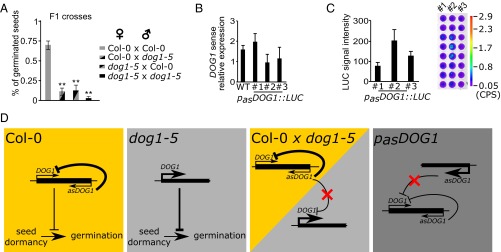Fig. 4.
DOG1 antisense acts in cis. (A) Germination efficiency (%) of freshly harvested F1 seeds from a dog1-5 × Col-0 cross. P values were calculated in comparison with Col-0 × Col-0. Mean values from at least three biological replicates with error bars representing SD. **P < 0.01. (B) An additional copy of asDOG1 introduced into Col-0 (WT) by transformation does not affect DOG1 expression. RT-qPCR was normalized against UBC mRNA; data are the means of three biological replicates with error bars representing SD. t tests show no statistical difference between WT and pasDOG1::LUC lines. (C) asDOG1 expressed from construct pasDOG1::LUC introduced into Col-0 (WT). The luciferase signal was quantified (Left) and visualized (Right) in freshly harvested seeds from the indicated transgenic lines. (D) Summary of evidence supporting the proposed model of cis-restricted asDOG1 regulation of seed dormancy. Yellow box: DOG1 antisense activity in Col-0 (WT) plants results in limited DOG1 expression leading to moderate seed dormancy strength. Gray box: the absence of asDOG1 in mutant dog1-5 results in high level expression of shDOG1, which strongly inhibits the transition to germination. Yellow/gray box: in Col-0 × dog1-5 F1 seeds the asDOG1 originating from Col-0 (WT) DOG1 is unable to silence the dog1-5 antisense-less copy of DOG1 in trans. Dark gray box: the addition of a construct expressing additional asDOG1 does not result in reduced DOG1 sense expression in trans.

